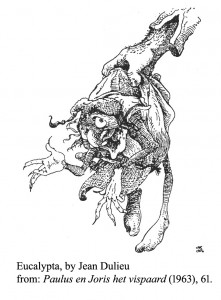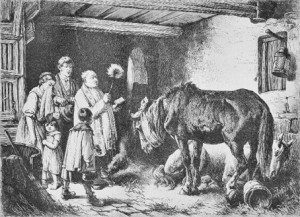Witchcraft
The historical anthropology of witchcraft
 An historical anthropological approach to witchcraft does not primarily imply the use of anthropological research on the subject, for instance about Africa, in historical research concerning Europe. The issue is more complex and abstract. To present some of my ideas about it, I have included three documents:
An historical anthropological approach to witchcraft does not primarily imply the use of anthropological research on the subject, for instance about Africa, in historical research concerning Europe. The issue is more complex and abstract. To present some of my ideas about it, I have included three documents:
– Anthropological influences: a translation of the section `Anthropologische invloeden’ of the chapter Typen van toverij (Types of witchcraft) in: Peter te Boekhorst, Peter Burke & Willem Frijhoff (eds), Cultuur en maatschappij in Nederland 1500-1850. Een historisch antropologisch perspectief. Meppel/Amsterdam and Heerlen (1992): 319-363, esp. 331-334.
– the paragraph on `The Researcher’s Position’ in: The Witch, her Victim, the Unwitcher and the Researcher. The Continued Existence of Traditional Witchcraft, in: Willem de Blécourt, Ronald Hutton & Jean La Fontaine, Witchcraft in Twentieth-Century Europe. London, Athlone (1999): 141-219, esp. 154-158.
– my reaction to Ed Bever’s The Realities of Witchcraft, in: Magic, Ritual and Witchcraft 5 (2010): 103-107.
Ph.D. Thesis
The main focus of this page, however, is to give an overview of my work on witchcraft in English and German; I started with writing articles in Dutch (original English summaries are included). There are brief references to the Dutch context if necessary.
I have studied anthropology at the University of Amsterdam where courses included witchcraft. These were, however, all about witchcraft in various regions outside Europe. When I discovered that witchcraft had been a regular feature of local Dutch history, I had found one of my main areas of interest. My Ph.D. thesis, defended at the Erasmus University in Rotterdam, focused on five centuries of witchcraft in the Dutch province of Drenthe. It was published as Termen van toverij: de veranderende betekenis van toverij in Noordoost-Nederland tussen de zestiende en twintigste eeuw. Nijmegen, SUN, 1990. In English it translates as Words of Witchcraft: the changing meaning of witchcraft in the northeastern Netherlands between the sixteenth- and twentieth centuries.
The original English summary is included here.
– sample fragment on the academic use of `witchcraft’ and similar terms.
Related articles:
– Evil people, see below under Beyond conference.
– The male witch. An essay on the meaning of seventeenth-century witchcraft insults (1991): unpublished.
– Hexenfamilien – Zauber(er)geschlechter. Das Beispiel Drenthe (17.-19. Jahrhundert), in: Eva Labouvie & Ramona Myrrhe (eds), Familienbande – Familienschande. Geschlechterverhältnisse in Familie und Verwandtschaft. Köln/Weimar/Wien, Böhlau (2007): 121-145.
The Dutch study group
In 1982 Marijke Gijswijt-Hofstra founded the study group Hekserij en toverij in Nederland, Witchcraft and sorcery in the Netherlands (this name was a compromise and an attempt to please all participants). We published two volumes of essays in Dutch:
– Kwade mensen: toverij in Nederland, edited by Marijke and myself. Amsterdam: Meertens Instituut (1986).
– Nederland betoverd: toverij en hekserij van de veertiende tot in de twintigste eeuw, edited by Marijke and Willem Frijhoff. Amsterdam, De Bataafsche Leeuw (1987).
plus a bibliography:
– Toverij in Nederland, edited by Fred Matter. Amsterdam: Meertens Instituut (1990).
A selection of the articles in the second volume of essays was translated into English as:
– Witchcraft in the Netherlands from the fourteenth to the twentieth century. [Rijswijk:] Universitaire Pers Rotterdam (1991).
I have contributed the following:
– (with Hans de Waardt), “It is no sin to put an evil person to death”. Judicial proceedings concerning witchcraft during the reign of duke Charles of Gelderland: 66-78.
– (with Freek Pereboom), Insult and Admonition: Witchcraft in the Land of Vollenhove, seventeenth century: 119-131.
– Four centuries of Frisian witch doctors: 157-166.
Later witchcraft articles in English and German
– (with Hans de Waardt), Das Vordingen der Zaubereiverfolgungen in die Niederlande: Rhein, Maas und Schelde entlang, in: Andreas Blauert (ed.), Ketzer, Zauberer, Hexen. Die Anfänge der europäischen Hexenverfolgungen. Frankfurt am Main, Suhrkamp (1990): 182-216.
– Witch doctors, soothsayers and priests. On cunning folk in European historiography and tradition, Social History 19 (1994): 285-303. [JSTOR]
– Mangels Beweisen. Über das Ende der Verfolgung von Zauberinnen in Niederländisch und Spanisch Geldern 1590-1640, in: Sönke Lorenz & Dieter R. Bauer (eds), Das Ende der Hexenverfolgung. Stuttgart: Franz Steiner Verlag (1995), 77-95.
– On the continuation of witchcraft, in: Jonathan Barry, Marianne Hester & Gareth Roberts (eds), Witchcraft in Early Modern Europe: Studies in Culture and Belief. Cambridge, CUP (1996): 335-352.
– The witch, her victim, the unwitcher and the researcher. The continued existence of traditional witchcraft, in: Willem de Blécourt, Ronald Hutton & Jean La Fontaine, Witchcraft in twentieth-century Europe. London, Athlone (1999): 141-219.
– The making of the female witch: reflections on witchcraft and gender in the early modern period, Gender & History 12 (2000): 287-309.
Bewitched cattle, 1875
– The Flying Witch: Its Resonance in the Sixteenth-Centurty Netherlands, Magic, Ritual, & Witchcraft 11 (2016): 73-93.
– The Laughing Witch: Notes on the Relationship Between Literature and History in the Early Fifteenth Century, in: Louise Nyholm Kallestrup & Raisa Maria Toivo (eds), Contesting Orthodoxy in Medieval and Early Modern Europe. Heresy, Magic and Witchcraft. London: Palgrave (2017), 255-277.
The `Beyond’ conference
In December 2000, Owen Davies and I organized a conference on witchcraft after the witch trials, at the University of Hertfordshire. This resulted in two books for which we solicited extra chapters:
– Beyond the witch trials. Witchcraft and Magic in Enlightenment Europe. Manchester, MUP (2004).
– Witchcraft continued. Popular magic in modern Europe. Manchester: MUP (2004). Both books can be found online.
I contributed:
– ”Evil people”: a late eighteenth-century Dutch witch doctor and his clients, in: Beyond: 144-166.
– Introduction: witchcraft continued: 1-13.
– Boiling chickens and burning cats: witchcraft in the western Netherlands, 1850-1925, in: Continued: 89-106.
The `Space’ conference
Organized in April 2010 by Cornelie Usborne at the German Historical Institute, London.
– ”Keep that woman out!” Notions of space in twentieth-century Flemish witchcraft discourse, History and Theory 52 (2013): 361-379. abstract
The Ginzburg critique
In 1984 I was asked to review Carlo Ginzburg’s The Night Battles in the context of the reports on a series of debates organized by the Amsterdam Sociologisch tijdschrift which included a dialogue between the historians Robert Muchembled and Carlo Ginzburg. This eventually resulted in a series of critical articles on the work of the latter, in Dutch, German and English:
– Volksmentaliteit or elitaire constructie?, Sociologisch tijdschrift 11 (1984): 555-560.
– Spuren einer Volkskultur oder Dämonisierung? Kritische Bemerkungen zu Ginzburgs “Die Benandanti”, Kea. Zeitschrift für Kulturwissenschaft 5 (1993): 17-29.
– The return of the sabbat: mental archaeologies, conjectural histories or political mythologies?, in: Jonathan Barry & Owen Davies (eds), Witchcraft historiography. Basingstoke, Palgrave (2007): 125-145.
– A journey to Hell: reconsidering the Livonian ”Werewolf”, Magic, Ritual & Witchcraft 2 (2007): 49-67.
Sabbat studies
The contribution for Witchcraft historiography led to work on the narrative aspects of the witches’ sabbat, which has been presented in conference talks not yet published
– Revisiting the Sabbat, or: The Dance of the Cats. Sixteenth Century Society Conference, Genève, 29 May 2010.
– Meetings on the Outside: Further Notes on the Histories of the Sabbat. Konferenz Grenzüberschreitungen. Magieglaube und Hexenverfolgung als Kulturtransfer , L’Institute historique allemand, Paris, 21 May 2010.
– Stories of the Sabbat. Hexensabbat. Tagung Arbeitskreis für Interdisziplinäre Hexenforschung, Weingarten, 28 Juni 2013.
– and in the chapter
Sabbath Stories: Towards a New History of Witches’ Assemblies, The Oxford Handbook of Witchcraft in Early Modern Europe and Colonial America, edited by Brian Levack. Oxford, OUP (2013): 84-100.
An edited volume, Precursors of the Witches’ Sabbat is scheduled to appear in 2018. To this I have contributed the introduction:
– Night Elves: Mistresses of the Night, Good Beings and an Innumerable Multitude of Women).
and the chapter:
– From Elves to Witches: Narrative Transitions in Early Modern and Modern Europe.
(Both titles are provisional). A table of contents will follow soon.
Jacques de Gheyn II, The Witches’ Kitchen, drawing ca. 1600.
The Cat and the Cauldron
Witchcraft in the Low Countries. This is an ongoing book project, but I am making some progress. See proposal.
Witches in Films
– Witches on Screen, in: Owen Davies (ed.), The Oxford Illustrated History of Witchcraft and Magic. Oxford: OUP (2017), 253-280.

